Menus
- Waiting for the new Hornet…
- No, the CB 650 F is not the replacement for the Hornet. Healthy, easy and fast enough, it is intended primarily for beginners looking for the first real “big cube” rather than for athletes at heart..
- Discovery
- In the saddle
- In the city
- Motorway and expressways
- Departmental
- Braking
- Duo and practical aspects
- Consumption
- Conclusion
Waiting for the new Hornet…
No, the CB 650 F is not the replacement for the Hornet. Healthy, easy and fast enough, it is intended primarily for beginners looking for the first real “big cube” rather than for athletes at heart..
Honda is in the process of completely overhauling its roadster offer. After dusting off its entry level with the CB 500, the world number one is now tackling “the floor above”. This floor is that of mid-size roadsters, a large organized bazaar including machines ranging from the peaceful Yamaha XJ6, Suzuki Gladius and other Bandit 650s to the much faster Kawasaki Z800, Suzuki GSR 750 or even Yamaha MT 09. This new CB 650 F, it would tend to be placed between the two, abandoning the sport in favor of versatility. And for a more radical machine, it will be necessary to wait for a (real) replacement of the Hornet whose production has just been stopped..
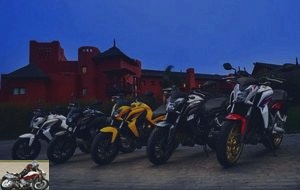
Discovery
During the press conference, Honda made it clear that its CB 650 F was going against the current trend which wants mid-size roadsters to continue to gain in displacement and power. Quite rare for the Japanese manufacturer, the target clientele is not clearly defined. The winged brand preferring to present this CB as "the first step in the Honda four cylinder range" and a transition machine between CB / NC and larger displacement motorcycles..
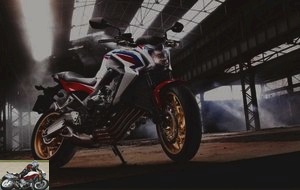
To design this new CB 650 F, Honda has developed a brand new 649 cc four cylinder. It adopts the same architecture as the sports units with a cylinder bank inclined at 30 ° and a gearbox and clutch assembly superimposed to gain in compactness. Admittedly, the output is modest with “only” 85.8 horsepower (64 kW) obtained at 11,000 rpm and 63 Nm of torque at 8,000 rpm. But Honda announces that it has worked on filling to offer maximum torque below the 6000 rpm mark, in particular with camshafts reducing to a minimum the valve crossing and elongated and narrow intake ducts (Ø 30 mm).
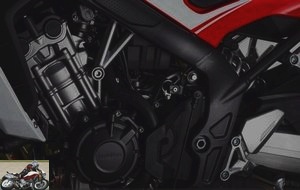
Service intervals are set at 12,000 km. Its look has also been particularly worked to hide the multiple hoses of the liquid cooling usually coming to ugly the crankcases. In the same vein, the exhaust manifold takes the characteristic design of the CB 400 of the 70s while the silencer has been compacted under the swingarm..
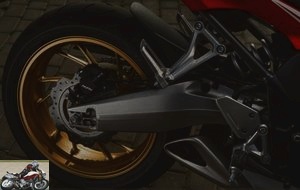
The double beam frame, also new, is made of steel and connected to an aluminum swingarm. The rear shock absorber works without rod and is adjustable in preload in 7 positions. As for the front axle, it seems borrowed from the CB 500: same fork diameter (41 mm), same 120 mm travel, same 25 ° 50 ‘caster angle, same 320 mm disc – but here there is some. two-pinched by superimposed 2-piston calipers … An ABS is also available as an option at an additional cost of 300 €. At the same time, a 35 kW version adapted to the A2 license will soon be marketed with ABS as standard, but Honda does not yet know if this model will be unbridled in “full”. In terms of availability and colors, the CB 650 F arrives in dealerships at the end of April in gray, black, yellow or in a special tricolor version (+ € 200) at a price of € 6,599.
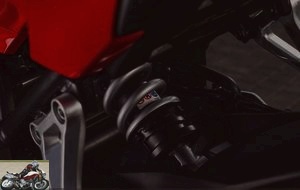
Aligned in a row of onions in front of the parking lot of our hotel on the heights of Alicante (Honda went to seek the sun in Spain), our CB 650 F look great. The style inevitably evokes the CB family with a triangular optic drawing very close to the small 500, just like the side covers covering the tank and the radiator. The compact front contrasts with the slender rear portion and gives off a soft image of sportiness.
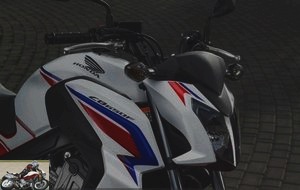
Made in Thailand, the CB does not have to be ashamed of its finish with quality paint, hair adjustments, beautiful welds, no protruding wire or hoses and the amount of granular plastics is reduced to the union minimum. Better, Honda even put an LED light at the rear. Not only is it fashion but in addition it costs less to change bulbs.
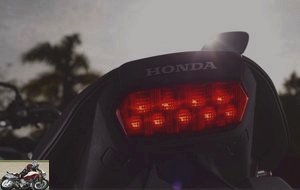
Above all, the four in line flatters the retina with its stainless steel BTR screws, its worked foundries and its escapement which makes its small effect on the right side. In short, pure Honda. There are still two, three details that annoy like the brake pedal stuck on an 80s cross country model or the exhaust pot that would have deserved a cover on the left side but not enough to provoke a wave of ritual seppuku among the Japanese engineers.
In the saddle
Good news for the dwarves, the driving position will be perfect for them with the torso slightly leaning forward, the hands resting on a handlebars narrower than the average and the legs flexed without excess. With a saddle 810 mm high (20 mm higher than a CB 500) and very narrow at the junction with the tank, it is possible to put the feet flat by measuring less than 1.70 m. The tallest of my colleagues (I found one of 1.82m) told me that they didn’t feel like a toad on a matchbox, but lamented a tank that was a little too large for their stems. The clutch is not adjustable unlike the brake lever.
In the middle, the backlit liquid crystal dashboard displays the speed and engine speed on its left side, while the opposite portion includes a clock, the fuel gauge as well as – optionally – the total mileage, two partial trips and the instant or average consumption.
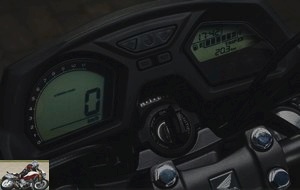
In the city
A pressure on the starter, the sound of the 650 is close to that of the Hornet, in more muffled.
In town, the novelty is similar to a super CB 500. Able to evolve in step without playing the balancing act, to turn around in a handkerchief, this 650 is disconcertingly easy. The setting on the angle is neutral and progressive, the clutch knows how to be forgotten, the box is irreproachable and the small four-cylinder is “perfect” in this kind of exercise. Able to resume on idle speed in sixth (20 km / h!) Without showing the slightest disapproval – but offering times worthy of a Velib ‘- it distils times worthy of the name from 4000 laps on the first three gears. . And without having tested the CB 650 F in traffic jams, the narrow handlebars and the short (but effective) mirrors suggest good skills in this area..
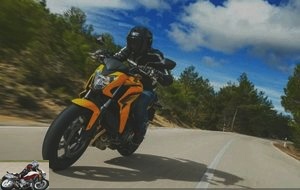
Motorway and expressways
Not surprisingly, the comfort speed is around 130 km / h before suffering from the lack of protection. For long journeys, the saddle should provide sufficient comfort with its wide rear portion and firm but not hard foam..
Stalled on the French speed limit, the engine runs at 6,000 rpm. Knowing that the red zone starts at 11,000 revs and breaks a little over 500 revs later, that leaves room … It should be noted that some parasitic vibrations appear from time to time in the handlebars depending on the engine speed without, however, appearing. show rude. While sailing at illicit speeds (+ 180 km / h), the stability is more than correct as long as you do not cling to the handlebars. But at this pace, the suspensions a bit firm have only moderately accepted the large bitumen fittings of the Spanish expressways. Nothing dramatic, for a non-sporting machine, we are largely within the standards of the genre.
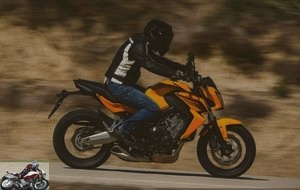
Departmental
The very variable quality of the bitumen from the hinterland calls for caution over the first kilometers. The specific Dunlop D222 F 120 / 70-17 at the front and 180 / 55-17 at the rear do the job well but have been a bit stingy when it comes to feedback. By alternating tight turns and quick sequences, the 650 F reveals a healthy and balanced chassis.
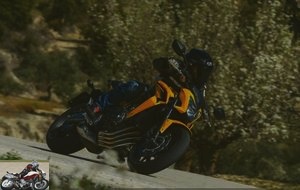
The front axle does not have the “bike” side of a CB 500 nor the edge of a Hornet, but the compromise between agility and stability is very satisfactory. On the engine side, the boot at mid-speed allows you to roll up without making the mechanics howl and the very gradual arrival of power combined with a fairly long pulling of the right handle means that you can easily adjust the arrival of the Powerful. Low unit displacement requires, care must be taken to maintain the needle between 7,000 and 10,000 revolutions to take advantage of the full potential of the 87 horsepower. Voluntary, the new block even offers a small extension of 1000 additional turns to the red zone. After, while driving well beyond the reasonable, the CB 650 F does not hesitate to show its disapproval. On the successions of bumps, the hydraulics lack of restraint in relaxation and can cause some pumping. And then there are the emergency entries on the brakes which freeze the front axle a little. Luckily, the good fore / aft tuning ensures that the machine never comes apart, just signaling that it’s time to cool down. In summary, this Honda can drive (very) fast but does not naturally encourage the gaudriole, preferring a fast-poured pace to the attack with the knife between the teeth..

Braking
The Wave discs use the same manufacturing process as the NC 750 with a 240mm rear disc cut inside the 320mm front discs to lower manufacturing costs. The two-piston calipers stacked at the front and the single rear caliper provide stopping power perfectly in line with the performance of the engine. The front brake combines bite, power and dosability and the ABS of our test machines has never been intrusive..

Duo and practical aspects
The passenger seat is relatively comfortable and has grab handles but remains very narrow in its rear part, forcing you to stick to the rider. It can make a good excuse to pass your backpack on the sandbag…
There is enough space under the saddle to accommodate a U or a rain suit and the rear loop incorporates two tie-down pins for an elastic net. And to improve everyday life, Honda offers a whole range of accessories including a 35 L top-case, a saddlebag that is attached to the passenger seat, a host of “carbon look” parts (seat cowl, wheel arch, mudguards …), engine guards, an alarm, heated grips…
Finally, like all Honda of the last generation, the ignition key has been shortened and is now of the Wave type in order to limit theft..
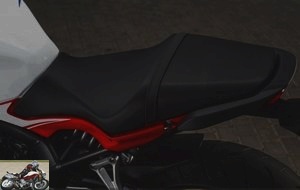
Consumption
With its 17.3-liter tank and a consumption of 4.8 L / 100 km in the WMTC standardized cycle, the advertised total autonomy is over 350 km. In real life, count more 300 km which places it all even in the high average of current roadsters..

Conclusion
With this CB 650 F, Honda has a roadster with an attractive look intended to appeal to the greatest number. Between its healthy and balanced part-cycle and its small four-cylinder valiant if not temperamental, it should delight all those looking for a good all-round machine, usable 365 days a year and rewarding. If we compare it only to other four cylinders, the CB plays placed. The Bandit 650 is a safe bet, but weighs over 30kg more while offering dynamic receding behavior. And compared to the Yamaha XJ6 (€ 6,799), the Honda is both faster (+ 10 hp) and less expensive. Faced with the twin duo MT-07 (€ 5,700) and ER-6n (€ 6,000), the game is much closer with machines that are certainly less versatile but much more exuberant. Faced with it, the Honda plays more on pragmatism than emotional fiber to seduce. Still, its selling price of € 6,599 does not make it the most affordable on the market. As for those who were waiting for a Hornet Next Gen – was it deflated but full of torque – they will have to chomp on their brakes a little more … Honda is talking half-heartedly about a higher displacement version which will probably be unveiled from here. the end of the year…
Strong points
- Ease of driving
- Comfort and stability
- Braking
- Finishing
Weak points
- Too wise for athletes
The technical sheet of the Honda CB 650 F
Competitors: Suzuki Bandit 650, Kawasaki ER6, Yamaha MT-07, Yamaha XJ6
Related articles
-
Ducati Multistrada Enduro test
160 hp at 9,500 rpm, 13.9 m / kg at 7,500 rpm, 4 driving modes, 257 kilos, € 21,390 A super sophisticated sports trail with proven versatility Let no one…
-
Ducati Scrambler Cafe Racer test
A more sporty version of the Scrambler with a neat look The Scrambler V2, 803 cm3, 75 hp at 8,250 rpm, 68 Nm at 5,750 rpm, 172 kilos, € 11,290 About 2000…
-
Harley-Davidson Road King Special test
V2, 1745 cm3, approx. 90 hp at 5500 rpm, 150 Nm at 3250 rpm, 355 kilos dry, from € 25,390 The Dark Custom spirit touches the queen of the road Discreet…
-
GT-Cruiser of the 3rd type The winged builder keeps up his ideas and keeps revisiting the contemporary bagger style. After the F6B and very soon F6C,…
-
Lumberjack power A BMW X5 stops next to me, looks at the motorcycle. Husqvarna? I thought they were just chainsaws! Well yes, it’s a lumberjack’s…
-
40 horses at 11,500 rpm 25.7 Nm, 175 kilos with full tank, two colors, € 5,799 An easy and sparkling little trail: what if life on a motorcycle was as…
-
Japanese Spice Choper. When Honda introduced the Fury in 2009, no one believed it … what could have prompted a Japanese brand to create such an extreme…
-
In-line twin, 471 cm3, 45 hp at 8,500 rpm, 44.6 Nm at 6,000 rpm, 190 kilos, € 6,299 A small accessible bobber intended for A2 licenses on a mechanical…
-
Moto Guzzi Nevada Aquila Nera test
A world of sweetness Charming in its black dress, the 750 Nevada is beautiful but wise for a 750 twin. A Moto Guzzi-style custom, that is to say that…
-
Honda CRF 250 L motorcycle test
A little trail that sparkles The great Escape You don’t like small cars? So be sure to read this article! Because after discovering this new Honda, you…